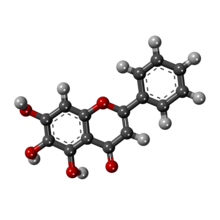Baicalein
Baicalein (5,6,7-trihydroxyflavone) is a
Baicalein, along with its
The flavonoid has been shown to inhibit certain types of lipoxygenases[12] and act as an anti-inflammatory agent.[13] It has antiproliferative effects on ET-1-induced proliferation of pulmonary artery smooth muscle cell proliferation via inhibition of TRPC1 channel expression.[14] Possible antidepressant effects have also been attributed to baicalein in animal research.[15]
Baicalein is an inhibitor of CYP2C9,[16] an enzyme of the cytochrome P450 system that metabolizes drugs in the body.
A derivative of baicalin is a known prolyl endopeptidase inhibitor.[17]
Baicalein has been shown to inhibit Staphylococcus aureus biofilm formation and the quorum sensing system in vitro.[18]
It has also been shown to be effective in vitro against all forms of Borrelia burgdorferi and Borrelia garinii.[19]
Glycosides
Tetuin is the 6-glucoside of baicalein.
See also
References
- ISBN 9781604562323.
- PMID 12561253.
- S2CID 260249283.
- PMID 23686791.
- S2CID 260251315.
- PMID 15584374.
- ^ S2CID 45903577.
- ^ S2CID 20133964.
- PMID 12620506.
- PMID 14692724.
- ^ ISBN 978-0-470-34434-7.
- S2CID 645610.
- PMID 18039391.
- PMID 21963569.
- PMID 21415537.
- S2CID 285706. Archived from the original(PDF) on 2008-12-17. Retrieved 2009-02-19.
- PMID 18650094.
- PMID 27128436.
- PMID 26457476.


